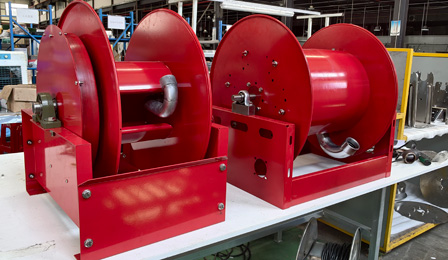Primary Categories and Characteristics of Industrial Hose Reels
October 28, 2025 | Industrial Hose Reels

Alright, industrial hose reels (also known as hose reels or hose winders) are devices used for storing, managing, and deploying various industrial hoses. They enhance work efficiency, ensure operational safety, and extend the service life of hoses. Below is a detailed explanation of their primary classifications and features:
I. Primary Classification Methods
Industrial hose reels can be categorized in multiple ways, with the most common classifications based on drive type, hose medium, and installation method.
1. Classification by Drive Method
This is the core classification method, determining the reel’s ease of operation and suitable applications.
Manual Reels
Operating Principle: Manually pull the hose using human force, with spring-assisted or hand-crank retraction.
Characteristics:
– Advantages: Simple structure, low cost, no external power required, easy maintenance.
– Disadvantages: Limited retraction force, suitable for lighter, shorter hoses; high labor intensity during frequent deployment/retraction.
Applications: Light-duty, infrequent use scenarios like air hoses, water hoses, welding hoses, and garden irrigation.
Spring-Driven Reels
Operating Principle: Utilizes a coiled spring as the power source. Pulling the hose out tensions the spring to store energy; releasing the lock mechanism allows the spring to release energy, automatically retracting the hose.
Features:
– Advantages: Automatic retraction, easy operation, space-saving, no electricity required.
– Disadvantages: Fixed retraction force; spring fatigue may reduce tension over time; unsuitable for heavy-duty hoses.
Applications: Suitable for medium-to-light hoses carrying compressed air, water, lubricants, acetylene, oxygen, etc. Widely used in workshops, garages, and production lines.
Electric Drive Reel
Working Principle: Powered by an electric motor, typically controlled via buttons or remote control for hose retraction/extension.
Features:
– Advantages: Powerful drive handles heavy-duty, long-distance hoses; precise control ensures smooth operation; enables automation.
– Disadvantages: High cost, requires power source, complex structure, demanding maintenance.
Applications: Heavy-duty, high-frequency use such as large oil transfer hoses, chemical transfer hoses, fire hoses, and large welding equipment.
Pneumatic-Driven Hose Reels
Working Principle: Utilizes compressed air as the power source to drive the motor, thereby rotating the reel.
Features:
– Advantages: Excellent explosion-proof performance, particularly suitable for flammable and explosive environments; strong power.
– Disadvantages: Requires a compressed air source, carries a risk of air leaks, and produces significant noise.
Applications: Hazardous areas requiring explosion protection, such as petroleum, chemical plants, mines, and paint spraying.
Hydraulic-Driven Reel
Working Principle: Utilizes a hydraulic system to deliver substantial power for reel operation.
Characteristics:
– Advantages: Provides immense torque and pulling force, suitable for ultra-heavy-duty hoses and cables; smooth and reliable operation.
– Disadvantages: Complex system, highest cost, potential for oil leakage.
Applications: Offshore engineering, large construction machinery, hose management for hydraulic equipment itself, ultra-high-pressure cleaning equipment.
2. Classification by Conveyed Medium
Depending on the substance flowing through the hose, reels feature specialized designs in material and structure.
Water Hose Reels: Used for water, hot water, or cleaning agents. Materials must be rust-resistant, with seals designed for water resistance.
Air Hose Reels: Used for compressed air. Typically marked in yellow, emphasizing sealing integrity and pressure resistance.
Oil/Fuel Hose Reels: Used for lubricating oil, hydraulic oil, diesel, gasoline, etc. Materials must resist oil corrosion, with extremely high sealing requirements and often incorporating anti-static design.
Chemical Hose Reels: For acids, alkalis, solvents, and other corrosive media. Hose fittings and reel housings require stainless steel or special coatings, with seals made of chemically resistant materials (e.g., Teflon, Viton).
Welding Hose Reels: Typically dual-hose or multi-hose configurations for simultaneous storage of oxygen, acetylene, and arc welding hoses. Structural design ensures strict channel isolation for safety.
Food/Pharmaceutical Grade Reels: Used for conveying beverages, dairy products, pharmaceuticals, etc. Constructed from stainless steel and materials compliant with food-grade certifications (e.g., FDA), facilitating easy cleaning.
3. Classification by Installation Method
Wall-Mounted/Wall-Fixed: Secured to walls or columns, saving floor space.
Ceiling-Mounted/Overhead: Installed on ceilings or brackets with hoses hanging vertically, occupying zero floor or wall space—ideal for large work areas.
Mobile/Cart-Mounted: Equipped with wheels or a base for flexible movement to required locations, offering high convenience.
Base-Mounted: Directly installed on the floor via a base for stable structure, suited for heavy-duty applications.
II. Core Feature Summary
Regardless of type, industrial hose reels share these common or optional features:
1. Enhanced Work Efficiency: Rapid hose deployment and retrieval eliminates tangling and dragging hassles, saving time and labor.
2. Extended Hose Lifespan: Standardized coiling prevents excessive bending, kinking, trampling, and abrasion, significantly prolonging service life.
3. Ensures Operational Safety: Maintains a tidy work area, preventing tripping hazards from haphazardly placed hoses. In hazardous environments, explosion-proof and anti-static designs are critical.
4. Space Management: Efficiently stores hoses, creating a cleaner, more organized work environment.
5. Protects Media Purity: For water, food, chemicals, etc., reels prevent internal hose contamination.
6. Multiple Optional Features:
– Limiters: Prevent excessive hose extension.
– Locking Mechanisms: Secure hose length at any position.
– Hose Guiders: Ensure neat, uniform winding on electric/hydraulic reels.
– Slip Rings: Enable continuous medium or power transfer during rotation, achieving 360° tangle-free operation.
Selection Recommendations
When selecting industrial hose reels, comprehensively consider:
Hose specifications: Inner diameter, length, weight, working pressure.
Conveyed medium: Determines material and sealing requirements.
Operating environment: Indoor/outdoor, explosion-proof, corrosion-resistant, temperature.
Usage frequency: Determines the choice of drive method.
Budget: Prices vary significantly from simple manual reels to fully automatic electric/hydraulic reels.